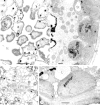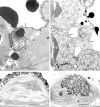Cell structural changes in the needles of Norway spruce exposed to long-term ozone and drought
- PMID: 14576076
- PMCID: PMC4243619
- DOI: 10.1093/aob/mcg202
Cell structural changes in the needles of Norway spruce exposed to long-term ozone and drought
Abstract
Effects of ozone and/or drought on Norway spruce needles were studied using light microscopy and electron microscopy. Saplings were exposed to ozone in open-top chambers during 1992-1995 and also to drought in the late summers of 1993-1995. Samples from current and previous year needles were collected five times during 1995. Ozone increased the numbers of peroxisomes and mitochondria, which suggests that defence mechanisms against oxidative stress were active. The results from peroxisomes suggest that the oxidative stress was more pronounced in the upper side of the needles, and those from mitochondria that defence was more active in the younger needle generation. Possibly due to the good nitrogen status and the active defence, no ozone-specific chloroplast alterations were seen. At the end of the season, older needles from ozone treatments had smaller central vacuoles compared with other needles. Cytoplasmic vacuoles around the nucleus were increased by ozone in the beginning of the experiment, and did not increase towards the end of the season as in the controls. These results from vacuoles may indicate that ozone affected the osmotic properties of the cells. Decreased number and underdevelopment of sclerenchyma cells and proliferation of tonoplast were related to nutrient imbalance, which was enhanced by drought. Larger vascular cylinders and more effective starch accumulation before and after the drought periods compensated for the reduced water status. Numbers of peroxisomes and mitochondria were increased in the drought-exposed needles before the onset of drought treatments of the study year, i.e. these changes were memory effects. Interactions between ozone and drought were few.
Figures





Similar articles
-
Cell structural changes in the mesophyll of Norway spruce needles by elevated ozone and elevated temperature in open-field exposure during cold acclimation.Tree Physiol. 2014 Apr;34(4):389-403. doi: 10.1093/treephys/tpu023. Epub 2014 Apr 8. Tree Physiol. 2014. PMID: 24718738
-
A cumulative ozone uptake-response relationship for the growth of Norway spruce saplings.Environ Pollut. 2004;128(3):405-17. doi: 10.1016/j.envpol.2003.09.008. Environ Pollut. 2004. PMID: 14720482
-
Significance of ozone exposure for inter-annual differences in primary metabolites of old-growth beech (Fagus sylvatica L.) and Norway spruce (Picea abies L.) trees in a mixed forest stand.Plant Biol (Stuttg). 2007 Mar;9(2):227-41. doi: 10.1055/s-2006-924648. Plant Biol (Stuttg). 2007. PMID: 17357017
-
The use of light and electron microscopy to assess the impact of ozone on Norway spruce needles.Environ Pollut. 2004;127(3):441-53. doi: 10.1016/j.envpol.2003.08.014. Environ Pollut. 2004. PMID: 14638305
-
Ozone-induced changes in the chloroplast structure of conifer needles, and their use in ozone diagnostics.Environ Pollut. 2005 Oct;137(3):466-75. doi: 10.1016/j.envpol.2005.01.033. Environ Pollut. 2005. PMID: 16005759 Review.
Cited by
-
Seasonal movement of chloroplasts in mesophyll cells of two Picea species.Protoplasma. 2020 Jan;257(1):183-195. doi: 10.1007/s00709-019-01427-6. Epub 2019 Aug 13. Protoplasma. 2020. PMID: 31410588
-
Fine structural quantification of drought-stressed Picea abies (L.) organelles based on 3D reconstructions.Protoplasma. 2010 Jul;243(1-4):129-36. doi: 10.1007/s00709-009-0058-3. Epub 2009 Jun 21. Protoplasma. 2010. PMID: 19544038
-
Antioxidant potential and essential oil properties of Hypericum perforatum L. assessed by application of selenite and nano-selenium.Sci Rep. 2022 Apr 13;12(1):6156. doi: 10.1038/s41598-022-10109-y. Sci Rep. 2022. PMID: 35418599 Free PMC article.
-
Efficiency of biomonitoring methods applying tropical bioindicator plants for assessing the phytoxicity of the air pollutants in SE, Brazil.Environ Sci Pollut Res Int. 2018 Jul;25(20):19323-19337. doi: 10.1007/s11356-018-2294-6. Epub 2018 May 25. Environ Sci Pollut Res Int. 2018. PMID: 29802616 Review.
-
Foliar symptoms triggered by ozone stress in irrigated holm oaks from the city of Madrid, Spain.PLoS One. 2013 Jul 22;8(7):e69171. doi: 10.1371/journal.pone.0069171. Print 2013. PLoS One. 2013. PMID: 23894424 Free PMC article.
References
-
- AlaviG.2002. The impact of soil moisture on stem growth of spruce forest during a 22‐year period. Forest Ecology and Management 166: 17–33.
-
- AlonsoR, Elvira S, Castillo FJ, Gimeno BS.2001. Interactive effects of ozone and drought stress on pigments and activities of antioxidative enzymes in Pinus halepensis Plant, Cell and Environment 24: 905–916.
-
- AnttonenS, Kärenlampi L.1996. Slightly elevated ozone exposure causes cell structural changes in needles and roots of Scots pine. Trees – Structure and Function 10: 207–217.
-
- AppleM, Tiekotter K, Snow M, Young J, Soeldner A, Phillips D, Tingey D, Bond BJ.2002. Needle anatomy changes with increasing tree age in Douglas‐fir. Tree Physiology 22: 129–136. - PubMed
-
- Bereiter‐HahnJ, Vöth M.1983. Metabolic control of shape and structure of mitochondria in situ. Biology of the Cell 47: 309–322.
Publication types
MeSH terms
Substances
LinkOut - more resources
Full Text Sources
Medical

